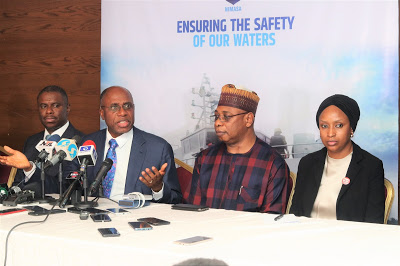by June
declared readiness to deploy its integrated maritime security infrastructure, in
an effort to comprehensively tackle insecurity on Nigeria’s territorial waters and
exclusive economic zone.
The Honourable Minister of
Transportation, Mr. Rotimi Amaechi, stated this Monday in Lagos while briefing
the media ahead of the launch of the Integrated National Security and Waterways
Protection Infrastructure, also called the Deep Blue Project.
press conference alongside all the heads of agencies under the ministry, also
explained the government’s decision to end the secure anchorage project, a
private security initiative run outside the country’s port system.
into the country must anchor at the national ports under the Nigerian Ports
Authority (NPA), which is an agency of the government, rather than allow a
private company provide such security for vessels.
Maritime Administration and Safety Agency (NIMASA), while expatiating on the
Deep Blue Project, said 80 per cent of the assets required for the takeoff of
the total spectrum maritime security architecture would be deployed by
June.
after a high level security meeting with maritime stakeholders, restated the
President Muhammadu Buhari government’s determination to tackle maritime
insecurity head-on.
Project, when fully operational, would drastically reduce piracy and other
crimes within Nigeria’s maritime domain and the Gulf of Guinea.
we secured an approval from the Federal Executive Council to introduce a
maritime security architecture, which is coming to fruition.
International (HLSI), who are only to provide training and equipment, while the
Nigerian Navy would lead the Police, Nigerian Army and Department of State
Services, among others that would run the equipment.”
the maritime sector needs a more holistic approach, hence the need to involve
other arms of the country’s security services to support the Nigerian Navy
working with NIMASA.
being installed under the Deep Blue Project, Dakuku revealed that a good number
of the assets had arrived the country, including six interceptor boats and a
special mission vessel, saying a second one would come in before the end of
February.
disclosed that the first special mission aircraft would be in the country
before the end of the first quarter of the year, while six armoured aircraft
were already in the country, and the first unmanned aerial vehicle would come
in before the end of February.
first helicopter in the first quarter of this year. Almost all the
communication gadgets are in the country as well as the Personal Protective
Gear (PPG). The C4i centre is fully operational in Kirikiri, the NIMASA
Research Centre. Those are the assets we have on ground.
this year, over 80 per cent of the assets would be in the country and they
would be manned by Nigerian military.”
aspect of the project had since commenced in phases.
for C4i operators and intelligence officers had been concluded. Basic infantry
training for soldiers who would fight on land around the littoral areas has
also been concluded and the soldiers awaiting deployment, according to him.
over time as we try to integrate the intelligence officers with the C4i and
those operating the special mission vessels and aircraft,” Dakuku said.

